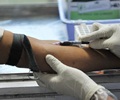Monitoring inactive chronic hepatitis B (HBV) carriers is a cost-effective strategy for China, according to a new study.

The World Health Organization (WHO) estimates that roughly 2 billion individuals worldwide have been infected with HBV—a virus causing acute or chronic liver disease that may lead to cirrhosis or liver cancer (hepatocellular carcinoma, HCC). WHO reports that 240 million are living with chronic HBV, with 1.4 million of those individuals in the U.S. according to estimates from the Centers for Disease Control and Prevention (CDC).
Previous research shows that 60% of the population in China has been infected with HBV and up to 10% are chronically infected, placing them at risk for life-threatening liver disease. In fact, medical evidence estimates that 500,000 Chinese die each year from HBV-related causes.
"China has the largest concentration of people infected with chronic HBV and understanding the health and economic impact is extremely important," explains Dr. Mehlika Toy from the Asian Liver Center at Stanford University School of Medicine who spearheaded the study while she was a Takemi Fellow at the Harvard School of Public Health in Boston, Massachusetts. "Our study is the first to analyze cost and cost-effectiveness of monitoring inactive CHB patients in Shanghai."
Using simulation models, the research team compared the current strategy of not monitoring inactive chronic HBV patients to a monitor and treat (M&T) strategy. The M&T strategy would include twice-yearly assessment of HBV and alanine transaminase (ALT) levels in patients with chronic HBV. For active HBV cases the researchers suggest treatment with entecavir, which evidence shows to be a cost-effective antiviral therapy in China.
Results show that there were 1.5 million adult carriers of HBV in Shanghai, with 63% of those hepatitis B virus e antigen (HBeAg) positive. The number of active cases of chronic HBV, were 258,139 HBeAg-positive group and 152,384 in the HBeAg-negative group. Researchers estimated that the M&T strategy would cost $20,730 (U.S.) and result in 15.45 quality-adjusted life-years (QALYs) per patient, compared to $20,455 and 15.35 QALYs for the current practice.
Advertisement
Advertisement















